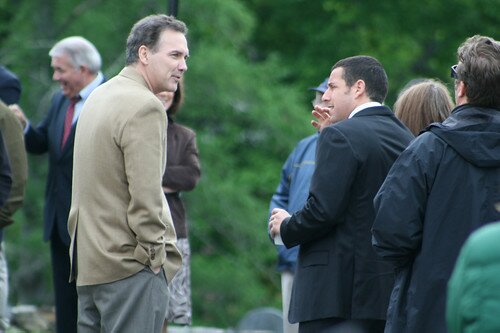So, now the truth has come out. Canadians are a people without “story”.
But then again: That’s what happens when, for so long, the thing that holds Canadians together was “not American.” And that’s why it’s so important that a “story” for Canadians is created out of the disparate building blocks that make up this series.
Now, the fact that Canadian have no “stories” could be tragic, or it could be magic, as the wonderful case of Norm MacDonald shows.
On the surface, Norm is an average-looking guy who likes to tell shaggy dog stories and make quirky observations. But then you see him utterly and repeatedly befuddle and confuse late-night maestro Conan O’Brien. You see him turn the tables on the hosts of The View, who accuse him of being insufficiently politically correct.
Or you watch some of his old material from SNL, when he wouldn’t stop making Michael Jackson and O.J. Simpson jokes while everyone else was afraid to (and for which he was, possibly, fired), or when he calls Jeffrey Dahmer “a real jerk”.
Norm MacDonald isn’t just a comedic genius, and he isn’t just someone who can stop an outrage mob with a shrug and a dad joke. He’s the holy fool personified, the ultimate court jester. Jeffrey “The Dude” Lebowski has nothing on Norm MacDonald.
It’s because Norm has somehow learned to turn the chaos that results when you abandon “story” to his advantage. Give Norm a movie, like Dirty Work, or his own talk show, and the best you’ll get is cult classic status. He doesn’t appear to want to be a star, or a household name. Success or failure means nothing to him, though you get the sense that he could conquer the comedy world if he only wanted to. Like his stories, Norm’s body of work is compelling and meaningless at the same time. He’s the Tom Bombadil of comedy: enormously powerful, yet deliberately ridiculous. Each subversion of the audience’s expectation is planned. You know he’s going to yank the rug out from under you, but you never see his next move until it hits you.
Despite his utterly conventional appearance, Norm doesn’t do “structure.” This is a man who’s gone bankrupt from gambling three times. He calls himself totally apolitical despite arguing that Bill Clinton was a murderer.
If “story” has power because it can transcend differences, there is also power in anti-story, though it is of course much more specific. Each Canadian culture creator is weird, although they are each weird in their own way. Thus, the same Canadian wellspring of weirdness that produced a David Cronenberg, a Jordan Peterson, and a Margaret Atwood produced Norm MacDonald. But it’s also why these creators, and their work, could not be reconciled with one another to create a unified Canadian culture.
This is why Canadians are “so funny”- because humour springs from the same place that horror does, from the unexpected and the uncanny. And while Norm’s brand of humour leaves the grotesque alone, there are plenty of Canadians who have pushed the boundaries of taste and normalcy so far that it eventually collapsed on them- though they got immeasurably rich in the process.
But we are going to have to wait one extra week before we cover the two Canadian masters of this horror-humour: Mike Myers and Jim Carrey. Unpredictable Canadian cultural weirdness does not follow a weekly schedule, and this past week it manifested in the most unlikely of places: a new episode of The Simpsons, which triggered a minor controversy out in Newfoundland. So: get ready to kiss the cod, you come-from-aways, and give a loud “Lard Tunderin’ Jaysus!” because we’re going to visit The Rock. (No, not the wrestler!)
******
See the previous installments in the series:
Part 1 on Heroes: ‘Scott Pilgrim Vs The World’ Vs Terrance Denby and ‘Sidequest’
Part 2 on “Humour”: The Libertarian Fantasy of ‘Letterkenny’
Part 3 on Graphic Novel Nihilism: The Harsh Truths of ‘Essex County’
Part 4 on Spawn and Wolverine: Banished From The Promised Land: A Tale of Two Canadian Anti-Heroes
Part 5 on Science Fiction Dystopias: Inside Quebec’s – and Canada’s – Replicant Culture
Part 6 on Animation: The Garrison Mentality: More Than Meets The Eye
Part 7 on Pop Music: How To Build A Successful Canadian Musical Act
Part 8 on Anne of Green Gables and The Traumatized Artist: Lucy Maud Montgomery’s Treacherous Alpine Path
Part 9 on Avoiding the Serious: Mordecai Richler, Montreal, And Gritty Realism
Part 10 on Southern Ontario Gothic: The Marriage of the Mundane and the Fantastic
Part 11 on Margaret Atwood’s Reign of Terror: Literary Tyranny and The Handmaid’s Tale
Part 12 on the First Nations Fraud: Whitewashing Genocide: Truth, Lies, and Joseph Boyden
Part 13 on the inventive Esi Edugyan: A Novel I Cannot Recommend Enough
Part 14 on Generation X Origins: Douglas Coupland And The Hopeful (?) Future Of Canadian (?) Culture
Part 15 on Jordan Peterson Rising: Canadian Culture Creators And The Intellectual Dark Web
Part 16 on The Awkward Quiet: David Cronenberg’s Silent Hell
Part 17 on The Saddest Music In The World: Guy Maddin’s Surrealist Madness
Part 18 on Ararat: Atom Egoyan’s Stammering Grief
Part 19 on Paul Haggis’ Superficial Gloss: Promising More Than He Delivers
Part 20 on the Reitman Family’s Blissful Ignorance: Space to Laugh an Easy Laugh
Part 21 on Mary Pickford: The Archetypal (Canadian) Actress
Part 22 on the Modern Prospero Christopher Plummer: As Blue-Blooded and Upper Canadian as They Come
Part 23 on Donald Sutherland: Grit Personified
Part 24 on Leslie Nielsen: The Funniest Thing in a Movie Where Jokes are Delivered Almost Every Minute
Part 25 on William Shatner: Faking It Until He Made It
Part 26, The Trouble of “Story”: Story Wars: Canadians and the Star Trek vs. Star Wars Battle



Comments
Leave a Reply